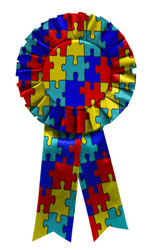MainosMemos contains the latest research and information about eye and vision care of children, developmental disabilities, Traumatic/Acquired Brain Injury and other topics of interest to me (and hopefully you!).
Saturday, August 8, 2009
Binocular motor coordination during saccades and fixations while reading: A magnitude and time analysis
Friday, August 7, 2009
All children should have eye exam by age 3
Thursday, August 6, 2009
Eye strain comments...
... has left a new comment on your post "Eye strain and convergence insufficiency":
This article raises a very good point. If anyone is suffering from symptoms of Computer Eye Strain or general eye strain, they should get evaluated by a Behavioral Optometrist who can test for such muscle imbalances as "convergence insufficiency", and give eye exercises to help with this problem. To locate a practitioner near you, go to www.eopf.org
Question about CI and ADHD
Anonymous has left a new comment on your post "What is ADHD (Attention
Deficit Hyperactivity Diso...":
My 9 year old son has many vision issues caused from severe prematurity; ROP, Convergence Insufficiency, misalignment, strabismus, etc. His vision issues can be helped with VT, but not completely resolved because of the severity. Our developmental pediatrician reccomends that we try “strattera” for possible ADHD. Mainly attention and mild impulse issues—NOT hyperactivity. Are you saying that vision issues, such as my sons, often look like ADHD symptoms--- but the symptoms are completely caused by the vision issues, not ADHD?
Comments: What the research shows is that a good number of children who have convergence problems have attentional problems and that many children with attentional problems have convergence problems. The ADHD symptoms can be caused by many factors....what I'm saying is don't over look the role vision may play... DM
Vision, learning screening could save young eyes
Topiramate Induced Acute Angle Closure Glaucoma
Comments: It seems as if 80% of my special needs patients are on Topirmate. Watch for increased IOP. DM
Ophthalmic findings in dyslexic schoolchildren
Comments: Children with dyslexia have a high incidence of convergence insufficiency according to this British Journal of Ophthalmology article. DM
ORTHOPTIC TREATMENT IN CONVERGENCE INSUFFICIENCY`
By C. E. Davies, M.D.
THE interesting part of the practice of ophthalmology is not confined to the operating
room, where the surgeon extracts a lens or secures a transplant, but is also very often
found in the refraction room, where judgment and experience are so important to the comfort
of the patient. This is particularly applicable in the case of convergence insufficiency....
Comments: More than 50 years ago, OMDs thought treating convergence insufficiency non-surgically was a good idea. What happened? DM
Eye strain and convergence insufficiency
and the main cause in persons aged 15 to 40 is convergence
insufficiency. It is more common in females than in males.
Many patients are supplied with glasses for eye strain
without the causative convergence insufficiency being
treated. The treatment in most cases is orthoptic exercises.
Comment: This article was written more than 30 years ago in the British Medical Journal.....why won't all of our OMD colleagues accept this? Even then it was known that orthoptics (aka optometric vision therapy) was the treatment of choice. DM
Make Eye Exams Part of the Back to School Routine
Comments: With all this talk about health care...we can't even seem to afford appropriate eye care for our country's children. Talk about having our priorities screwed up! DM
Neuroscientist discusses how optometric vision therapy helped her to develop stereovision.
From AOAs First Look:
Neuroscientist discusses how optometric vision therapy helped her to develop stereovision.
Signs of Vision Problems in Children Video
The five most common signs that your child may have a vision problem.
The five most common signs that a vision problem may be interfering with your child's ability to read and learn are:
- Skips lines, rereads lines
- Poor reading comprehension
- Takes much longer doing homework than it should take
- Reverses letters like B's into D's when reading
- Has a short attention span with reading and schoolwork
Dr. Carole Hong is Board certified in vision development and vision therapy who diagnosis and treats vision problem that interfere with reading, learning and 3D/stereo vision, and practices in san Carlos, California. She holds the office of Vice-President for the COVD, College of Optometrists in Vision Development.
The College of Optometrists in Vision Development (COVD) is an international, non-profit optometric membership organization that provides education, evaluation and board certification programs in behavioral and developmental vision care, vision therapy and visual rehabilitation.
CI & ADHD
Comments: Although I mentioned this study before....it's worth mentioning again and goes well with the study I noted just prior to this post. Please note I added [comments] supported by current research above. DM
Nearpoint phorias after nearwork predict ADHD symptoms in college students.
Comments: The evidence continues to mount that vision system function and behaviors related to ADHD are closely associated. DM
Medicines Top Cause of Poisoning in Kids
Difference in binocular rivalry rate between patients with bipolar I and bipolar II disorders
Prevalence and Causes of Visual Impairment in African-American and Hispanic Preschool Children: The Multi-Ethnic Pediatric Eye Disease Study
Comments:This means that there are thousands....maybe tens of thousands of children who need optometric vision care. This also means that if all had participated in the AOA's InfantSee program, most would not be amblyopic now. Dear ophthalmology colleagues, are you now convinced that full pediatric eye examinations should be required for each and every child? It seems like the vision screenings most of these children participated in at school...missed the problems! How sad and unfortunate for these children and their families. DM
Neurobiological Approaches on Brains of Children with Dyslexia: Review
Rhythm Reproduction in Kindergarten, Reading Performance at Second Grade, and Developmental Dyslexia Theories
Medically unexplained visual symptoms in children and adolescents: an indicator of abuse or adversity?
Wednesday, August 5, 2009
SOVOTO the Vision Therapy Connection
What Is Concussion? What Is Mild Traumatic Brain Injury (MTBI)?
Comments: Even mild brain injury can have lasting eye and vision problems long after the obvious problems have been attended to....go to http://www.covd.org to find a doctor who can help. Also go to http://www.covd.org/Home/OVDJournal/OVD401/tabid/263/Default.aspx for a whole Optometry & Vision Development theme issue on traumatic brain injury. DM
ADHD in School Video for Parents
Neurological Differences Support Dyslexia Subtypes
What is ADHD (Attention Deficit Hyperactivity Disorder)?
Comments: This is a nice review of ADHD and for the most part has correct information. It does not mention the current studies that show up 3 X's more children with ADHD have vision problems and 3 X's more children with vision problems have ADHD characteristics. Have your child's eyes evaluated today. Go to http://www.covd.org for doctors who evaulate the vision problems affecting children with ADHD. DM
What is Autism? What Causes Autism?

Autism is known as a complex developmental disability. Experts believe that Autism presents itself during the first three years of a person's life. The condition is the result of a neurological disorder that has an effect on normal brain function, affecting development of the person's communication and social interaction skills....People with autism have issues with non-verbal communication, a wide range of social interactions, and activities that include an element of play and/or banter....
BrainandSpinalcord.org
Real Time Snapshot Of The Learning Process
Biological and Medicinal Properties of Grapes and Their Bioactive Constituents: An Update
Comment: I like red wine. The fact it has good stuff in it is good too! Cheers! DM
Genetic risk, not anesthesia exposure, impacts cognitive performance
Tuesday, August 4, 2009
Effectiveness of screening preschool children for amblyopia: a systematic review
Comments: If the literature on this is so bad that they can't come to a conclusion...how good can vision screening be for amblyopia? Children should have full, comprehensive vision examinations. No ifs. No buts. No maybes. We could eliminate most of the amblyopia in the USA if all infants would participate in the AOAs InfantSee program. Go to http://www.InfantSee.org today to learn more. DM
Brain Exercise Might Delay Dementia-Related Memory Decline
For each additional activity day spent reading, writing, doing crossword puzzles, playing board or card games, having group discussions, or playing music, older individuals who eventually developed dementia delayed the onset of accelerated memory decline by more than two months (P=0.016), according to Charles Hall, PhD, of Albert Einstein College of Medicine in New York City, and colleagues....
More Vision Wars: Visual Training for Dyslexics
While not all children or adults with dyslexia have visual processing problems, many--at least two-thirds in some studies--do. This makes sense from a neurological standpoint, because several of the structural neurological features associated with dyslexia appear to predispose to visual difficulties. ... Consequently, it should not be surprising that their visual movement functions, which are controlled by many of the same neural pathways, are also poorly coordinated.....In one study of dyslexic children, just one type of visual problem, near-point convergence insufficiency, was present in 30-40% of the dyslexic children, compared to just 20% of controls. ... For children with convergence insufficiency, peer-reviewed NIH sponsored research has shown that home therapy can work as can home exercises with computer training, but that in-office therapy shows the best efficacy. ... for children who have both dyslexia and visual problems, interventions (whether visual exercises, vision therapy, or glasses) will often improve their ease and endurance for reading.
Comments: Vision therapy fixes vision problems....and prepares the individual to read more easily, comfortable and efficiently. The latest rounds of attacks by organized medicine do not change this fact. It is sad that some of our MD colleagues do not recognize this. DM
New Theory about Autism Roots
Comment: Interested in Autism? Read this Scientific American article today.DM
From 2-D to 3-D Sight: How One Scientist Learned to See
Scientific American:...LEHRER: How did you regain 3-D vision at the age of 48?
BARRY: Even though I had three childhood surgeries to "correct" my crossed eyes, I still did not see in 3-D. After the operations, my eyes looked cosmetically straight but they were still slightly misaligned....In my late forties, I consulted a developmental optometrist who prescribed for me a program of optometric vision therapy designed to stabilize my gaze. Since I was cross-eyed, I looked at visual targets with one eye and turned in the other. The vision therapy procedures provided me with the feedback I needed to know where in space each eye was looking. With this feedback, I learned to aim the two eyes at the same location in space at the same time and, to my astonishment, began to see in 3D. Further therapy taught me how to integrate my new 3D views with my former ways of judging depth and distance....
Comment: Click on the title to read more of the interview. DM
Monday, August 3, 2009
Obsessive-compulsive disorder: Nearly a lifetime without treatment

Anthony Barone a long time employee and the first friendly face most folks see as they come to the Illinois College of Optometry is out to help people with obsessive complusive disorders... I've known Anthony for decades, and he represents the very best of ICO and the individual we employ. Click on the title for the story in the Chicago Tribune. DM